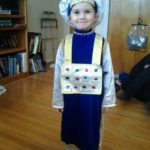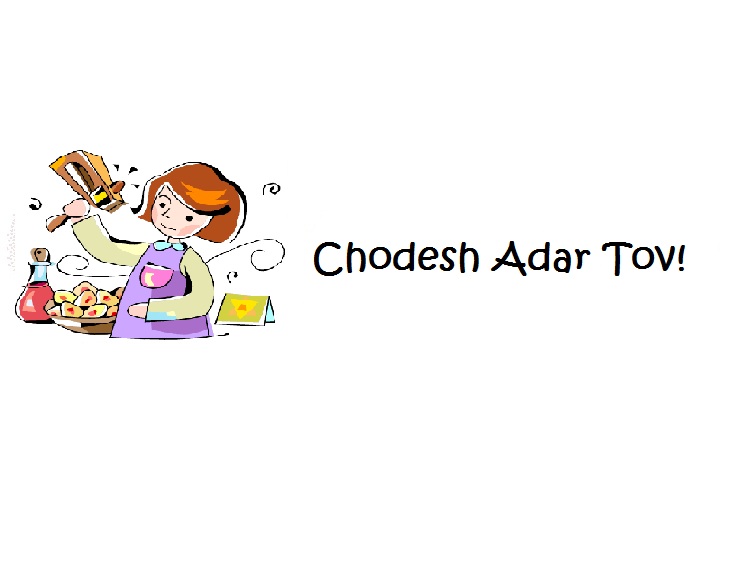
Chodesh Tov everyone! Purim is but 2 weeks away!
I started this this past week but there was just no time to finish it. I hope everyone is staying warm. The snow storm dumped close to 18 inches of snow on us. Shabbos morning I looked outside the window over my bed and oh, how I wished I could take a picture! It had to wait until this morning, but when I looked this morning, the trees were not quite as beautiful as yesterday. Almost, but not quite. We did not get to go to shul this week for there was no way a wheelchair could have been pushed through the snow that remained from the snowplows. But I did get outside on my way to my shiur and just enjoyed all the snow covered, glistening trees. It is hard to tell with the boys, but the little bit of Charlotte Mason style of outdoor science we have done has sure had an effect on me. When coming home I noticed all the little tiny footprints made by the resident squirrel on our property. I even noticed the huge gaping hole in the snow under one of his favorite trees. What was he doing there? What made that hole? Was he looking for the leftover challah scraps that we put out there from the previous week’s leftover challah? Or, as I was try strain my head, did he drop some snow from the branches above? And then, after Shabbos, boys came and enjoyed themselves all over those marks in the dark while I was snow blowing the driveway. Ah, the joys of being a child. Though, all 4 of them came out, on their own, and WANTED to help me clean the driveway! Sweet boys!
I guess this week was a fairly successful week. I would say this is the first week that we are really back into our routine – not quite, but just about. I would have probably have gotten to the little tiny bit that we lacked this week if it were not for my mind focusing on our new found room! All the boys in one room has actually turned out very well and we have decided to make the new room our library. Up came the unused bookshelf (GASP!! How could we, as homeschoolers, have an empty bookshelf?) and a desk.
Never fear, the bookshelf is now full! Living room has been emptied of the loose books that never could all fit on the shelves there, two comfy chairs and ottomans bought (from the Love Sac) and voila! School has a new location now. There is still work to be done in both the boys’ room as well as our new library, but there is something called money that we need to wait for now.
I read an amazing post this past week. As a quick precursor, we are finishing our third year with our Charlotte Mason curriculum (Ambleside Online version). I was not looking for a curriculum but I happened to bump into it. As I was reading the AO website I realized this is what I was looking for and what I needed. A CM curriculum is very different from the standard secular curriculum that is found nowadays in most schools. One of the main differences is that we focus on oral narrations for the first 3-4 years and only after those are mastered do we add written narrations. So, most of what the boys are doing is all oral with discussions. After all, how can you expect a child to write about what he has just learned if he cannot even voice in words orally all about it for it is easier to verbalize than it is to write.
Online version). I was not looking for a curriculum but I happened to bump into it. As I was reading the AO website I realized this is what I was looking for and what I needed. A CM curriculum is very different from the standard secular curriculum that is found nowadays in most schools. One of the main differences is that we focus on oral narrations for the first 3-4 years and only after those are mastered do we add written narrations. So, most of what the boys are doing is all oral with discussions. After all, how can you expect a child to write about what he has just learned if he cannot even voice in words orally all about it for it is easier to verbalize than it is to write.
Everything sounded great, except one thing. HOW do you actually teach? Well, the short (or really long) answer is to start reading all of Charlotte Mason’s books (there are 6 in her series.) When you are 3 days before the first day of school it was really not something that was doable then. I got the idea that the child is suppose to either read (or be read to) the particular pages in the book and then the child is suppose to narrate back what he/she just read/heard. There was nothing really to “teach.”
I really like the books used and the other main ideas of the curriculum that I kept up either reading to boys or having them read by themselves and then come narrate. It was not until the next summer that I was able to do more reading on what I, as the teacher, was suppose to do. As the second year with AO started, I noticed I was starting to getting the hang of things. Yes, narration from the child is the most important part – did the child understand what he/she just read? There are the obvious set of questions – the 5 W’s – Who, What, When, Where, Why and How.
 The way AO is set out, we noticed that “Oh! Hey, we ready about this guy a few months ago!” The wonderful ladies who set up AO did a wonderful job for they arrange the books in each subject each book talks about a person or event in a different light and then to see the lights turn on in those little precious minds as they connect the dots when they hear about something they learned about before is always fun and exciting. I have even been able to bring in Torah thoughts and ways into many of our lessons. It is exciting to me to see myself growing and learning as a teacher. I think I am finally getting it. It does take practice but it is coming easier for me.
The way AO is set out, we noticed that “Oh! Hey, we ready about this guy a few months ago!” The wonderful ladies who set up AO did a wonderful job for they arrange the books in each subject each book talks about a person or event in a different light and then to see the lights turn on in those little precious minds as they connect the dots when they hear about something they learned about before is always fun and exciting. I have even been able to bring in Torah thoughts and ways into many of our lessons. It is exciting to me to see myself growing and learning as a teacher. I think I am finally getting it. It does take practice but it is coming easier for me.
And then, I read this wonderful post. The writer starts off by describing part of a phone call she got from another mother:
Mom: What do I do when my son retells the details of a book or movie or story, but he can’t tell me the overarching narrative that goes with it? Like he can’t say the main plot points. He rambles and gets caught up in details that are non-essential to the plot, but he tells them with so much accuracy and depth, I hate to stop him.
Her son is 11.
I can relate. One of my sons can read for 10 minutes and narrate the entire thing in 20 minutes. But then, I have one that has problems remember a tiny section (2 paragraphs) and he usually ends up just being able to narrate the last thing that was mentioned and cannot remember what happened before unless I start him off. But what about the first child? The author then precedes to start her answer off with the following:
Adults summarize. They can pick out the main points and sequence them. They’ve read 1000s of stories, watched as many films, and are well aware of the narrative arc (plot diagram) by virtue of time on the planet and years logged reading/absorbing “story.”
Kids don’t have this background, and can’t summarize like you. They’re younger. Story is fresh for them. They are beguiled by subplots and character quirks and twists. They chase the shiny object called “weapons,” “cute puppies,” “sassy friends,” “weird creatures,” “magic spells” or “epic battles” and report all that is filling their imaginations to the brink of enthusiasm. When you ask them to tell you about the story, the most exciting, fascinating points overflow. They can’t “sort” the images and emotions. They aren’t likely to sequence events into the narrative arc. They retell the memorable moments, with detail, reliving them in front of you.
I think that is something that we have to keep in mind with many things. How many of us adults would be in heaven with one cardboard box? How many children would be in heaven with a cardboard box? I think my oldest is now teetering on turning more into an adult, but all three younger boys (ages 11 and below) will have lights in their eyes if I tossed them a box for them. To them, the idea of a cardboard box is still new and exciting. To us adults, well, it is old and no longer are we interested in those “simple” things in life. It is by virtue of all the 1000’s of experiences that we have growing up that we are able to weed out the “unnecessaries” (that are always necessary, just not the “ikur”, the main point, of an experience,) and get right to the chase or make that connection between different things.
The author goes on and describes how to help children sort everything out, how to help the child visualize what is going on and put it all in order. It was really interesting, although someone on my AO list pointed out that some of tactics, she feels, are not quite CM style, and some of what the blog states is made more for the high school level of CM opposed to the younger children (mainly the more technical points – like “protagonist” and “sub-plot.”) Then, the mother proceeds to add that not all children can visualize like this author is almost assuming (my child 2 example from above who can narrate only the ending of a section and cannot remember anything before.) What this mother did with her similar-minded child was to stop after each sentence or tiny section (could be 2 or 3 sentences….) and have the child visualize what is going on – not narrate, just visualize in his mind. She would do this for the entire reading, asking her son to visualize what she just read and then add that visualization to the previous ones. At the end of the entire reading he was to then visualize it all and narrate.
I agree with this mother that those of us who are teaching a CM curriculum are not wanting to teach all these wonderful living books in order for our children to be able to analyze them to death and we have to be careful when asking for narrations and then analyzing them with the children. I think this post is good but best used after finishing a book and mainly for the higher leveled students. When trying to apply this to younger students, a more watered down (basic) version should be used.
All in all, I am reminded about how much I do not yet know and will have to pick up Miss Mason’s books again in the summer!
 Well, I finally did it. I now have a Facebook page! Just go to Jewish and Homeschooling in an Amazing World and you can join the group. This will hopefully be a medium where I can also post other interesting links and information that I find. Purim is but a few days away and I saw that someone posted hamantashen on Facebook and realized that with all our planning we did, we did not plan making any this year! Oops. That will not do. The little one and I made a batch of hamantashen after supper tonight.
Well, I finally did it. I now have a Facebook page! Just go to Jewish and Homeschooling in an Amazing World and you can join the group. This will hopefully be a medium where I can also post other interesting links and information that I find. Purim is but a few days away and I saw that someone posted hamantashen on Facebook and realized that with all our planning we did, we did not plan making any this year! Oops. That will not do. The little one and I made a batch of hamantashen after supper tonight. (mainly for the benefit of the little one, but it still gives me a chance to add in stuff for the older ones.) Yesterday was parsha day. It was a perfect parsha for in it we talk about the clothes for the kohanim and the kohain gadol, and guess who is excited about being a kohain gadol for Purim this year? Thanks goes to his wonderful Aunt who had no more use for the costume and sent it to him. He was very excited and proud to be able to take out the costume and put it on for we really needed it for school! We compared what clothing the kohain gadol really wore with the costume version. There were a few differences, some which the boys asked if we could fix. But even if we don’t add any of the missing fixtures, we all agreed that it was a great costume and the little one looked quite spiffy. 🙂 The costume was put away again until Motzei Shabbos.
(mainly for the benefit of the little one, but it still gives me a chance to add in stuff for the older ones.) Yesterday was parsha day. It was a perfect parsha for in it we talk about the clothes for the kohanim and the kohain gadol, and guess who is excited about being a kohain gadol for Purim this year? Thanks goes to his wonderful Aunt who had no more use for the costume and sent it to him. He was very excited and proud to be able to take out the costume and put it on for we really needed it for school! We compared what clothing the kohain gadol really wore with the costume version. There were a few differences, some which the boys asked if we could fix. But even if we don’t add any of the missing fixtures, we all agreed that it was a great costume and the little one looked quite spiffy. 🙂 The costume was put away again until Motzei Shabbos.



